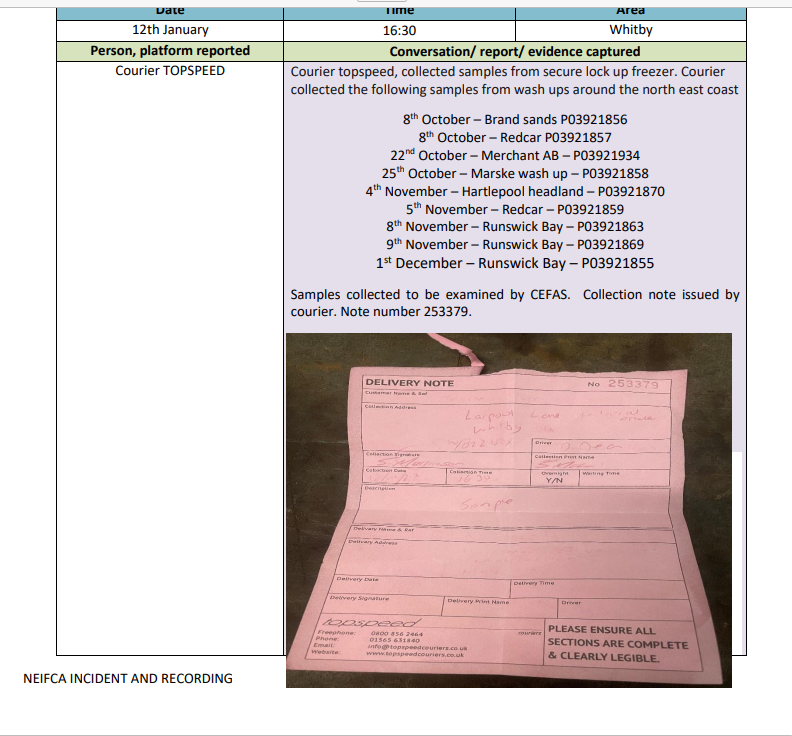Political Science:
Defra Gaslights
with Cefas
Research Report

Dead Crustaceans on Saltburn Beach, 2022
Scott Hunter
12 November 2023
For many, the publication on 3 November of a new report on the 2021 North East crustacean die-off came as a bolt out of the blue. After all, Defra had already closed its investigation down in February 2022; then appointed an independent panel of experts appointed in November 2022 to review the evidence. It published its findings in January of this year.
More curious still is the fact that, in a press release published at the end of November 2021, it stated that it had ruled out contamination as a possible cause of the mortality. A couple of months later, before shutting its investigation down completely, it claimed that the cause was an algal bloom. This was met with derision, especially from local fishers, but Defra stuck with it until its own independent panel concluded that it was nonsense.
The independent panel, in turn, concluded that the die-off may have been caused by an unknown pathogen, and that seemed, once again, to be the end of it. Then, all of a sudden, a research paper by Defra partner agency, Cefas (the Centre for Environment, Fisheries and Aquaculture Science) appears, and takes us right back to where we started – to the question of contamination. And then rules it out all over again.
The problem for Defra is that the idea that this was a pollution event began with one of its own partner agencies – the Environment Agency (EA). As event unfolded in the autumn of 2021 it was the EA that led the investigation, and the evidence they collected yielded only one possible explanation – contamination with volatile organic compound, pyridine. This had them scratching their heads, however, as pyridine, on account of its volatility, was considered an unlikely cause of a prolonged mass mortality event such as this.
But pyridine presented the authorities with another problem. If it were officially recognised as the cause, then they would have to start searching for the source, and that could prove to be embarrassing. Pyridine was present in undoubtedly vast quantities around the coke batteries on the site of the former steelworks on the south bank of the Tees. It had been there for decades without triggering mass crustacean mortality. So, what had changed?
Fishers initially blamed it on dredging, but this eventually started to look unlikely, as it became clear that only routine maintenance dredging had been carried out in the relevant time frame. That being the case, had something triggered a massive discharge of pyridine from the Teesworks site? That possibility has not been officially investigated. But the awkward fact remained that elevated levels of pyridine had been found in the crustacean tissue.
So, how does Defra respond? By taking over control of the investigation and shutting it down. Or so we thought. The publication of the Cefas research on 2 November seems to show that Defra had continued to take the issue very seriously. Until you look more closely, that is.
Cefas undertook to a research programme to establish a quantitative method for detecting the presence of pyridine in shellfish tissue and sediment. When the Environment Agency analysed such samples in 2021 no such method was available to them, so a qualitative method was used instead. In so doing they re-analysed tissue samples previously examined by the Environment in October and November 2021, samples in which elevated levels of pyridine were found in shellfish from the seas around Tees Bay, but not in control samples from elsewhere.
We have no reason to cast doubt on the scientific rigour of the method they developed to detect pyridine in the samples. On the other hand, the choice of samples itself reveals something of the true motive behind the research. It reanalysed the samples first analysed by the EA in October and November 2021. They present those results in the table below:

That is to say, the Cefas study used tissue from five samples from the affected area and twelve from elsewhere, the latter being for the purposes of comparison with the Tees Bay ones. The result of their analysis is described in the following terms:
“Whilst the sample size is small, an unpaired t-test comparing values obtained from all crustacean tissue samples (where exact sample provenance was known and using a conservative estimate of results between LOD and LOQ of 0.02mg/kg), derived from the within the affected area and, those collected from unrelated areas revealed no significant differences in pyridine content (mg/kg) (P<0.05)”
This, then leads them to conclude, “Data presented in this study provide additional evidence supporting the conclusion that it is very unlikely that pyridine, as a single chemical entity, was the cause of the crab and lobster mortalities during autumn 2021.”
So, that, it appears, wraps things up. Again. They admit that the research is based on a small sample, but the mortality event, after all, is now over. The research might have benefited from access to a larger sample, to improve the reliability of its findings, but where would they get those from after the event?
Actually, from their own freezers.
Cefas had lots of other samples, they just chose not to use them, as indicated in evidence we have seen from the logs of the North East Inshore Fisheries and Conservation Authority (North East IFCA), another Defra partner agency, who collected further samples and dispatched them to Cefas.

During the autumn of 2021, North East IFCA collected samples principally of crab and lobster. At this time they were collecting moribund shellfish, freezing them, and putting them into storage. On 1 December they also collected a sample of octopus, washed up at Runswick, the only sample taken of an animal already dead. These samples, professionally collected and stored, were delivered to Cefas on 12 January 2022, as this despatch note shows:

After December 2021 North East IFCA’s records show that there was a pause in the collection of samples. In May 2022, however, they started collecting samples again and these were also dispatched to Cefas:

These samples were of already dead shellfish. At this time fishers were reporting that they were finding dead crustaceans in their pots. Also, local merchants were reporting that crab and lobster were dying in disproportionate numbers in their storage tanks shortly after arrival. Samples from both sources were included in the batch sent to Cefas on 25 May. But neither the 12 January samples nor the 25 May samples were analysed during the research. The research report states that the tissue samples used were collected from EA in April 2022. So, why not use all of the samples they had available?
This statement is from the Executive Summary of the report:
“Due to continuing external concerns over pyridine, Defra commissioned this work at Cefas to develop and validate a robust quantitative method for pyridine in these environmental matrices”.
There certainly have been ‘external concerns’. These were first raised by Tim Deere-Jones in a report submitted to the North East Fishing Collective in January 2022 and published the following month. Deere-Jones did not produce his own evidence, however. He obtained the EA data through FOI and published it. However, by that time the Cefas research had already been commissioned, as stated here in the Background section of the report:
“In December 2021 Defra commissioned the Centre for Environment, Fisheries and Aquaculture Science (Cefas) to develop and validate a fully quantitative method for pyridine in biota and sediments”. [where ‘biota’ are shellfish tissue samples]
In other words, the research was commissioned specifically to discredit the analysis results obtained by the Environment Agency. Nothing more.
While we are not competent to comment in detail on the science, Dr Simon Gibbon, visiting professor of materials at the University of Manchester, has commented to us that it would have been more rigorous for Cefas to have replicated the EA’s method of analysis of the samples as well as conducting their own tests. This would have given clarity on whether there had been degradation of the samples over time. So the new research does not achieve its own objective on those grounds alone.
Dr Gary Caldwell of Newcastle University, who, in 2022, undertook seminal research on the toxicity of pyridine to crustaceans has given detailed critique and criticism of the research. That is available here: https://twitter.com/applied_marine
In it he points out that publication of the report, dated September 2023, coincided with a meeting of the Joint Councils’ Crustacean Die-off Working Party. So, it appears, Defra just held on to it for two months until a suitable media opportunity arose when they could get maximum publicity benefit from it.
Given that this was a research report, it has no comment to make on the wider question of what the actual cause of the mortality might have been. Presumably Defra would like us to believe that it was the work of an unknown pathogen as ‘independent panel’ indicated tentatively in January. But there is one key feature of the EA investigation that has been conveniently overlooked, which is what prompted them to look for contamination in the first place.
And the answer is that they could smell it, as is revealed in the North East IFCA logs. This report from 25 October 2021, states that when officers of NEIFCA, the MMO and EA attended the beaches a Saltburn-Marske they found large pockets of dead shellfish, fish and seaweed. They report “There were no rotting smells on the beach. When pockets were approached there was strong, toxic chemical smells coming from the areas”.

So, Defra has now repeatedly claimed that pyridine was not the cause. Both the Independent Panel report in January and this Cefas research claim that pyridine is not the cause. If they continue to insist that this is the case, they need to redouble their efforts to discover what contaminant it was that was causing the ‘toxic, chemical smell’ on the beaches around Teesmouth. Because the presence of contamination is undeniable.
And given that the EA ruled out spillage from one of the industrial plants on the Tees, that leaves only Teesworks as a possible source. Pyridine, along with a basket of other toxins, has been ‘resting’ on that site for decades. Did something happen in September 2021 to dislodge it? Is what happened on the site an example of disregard for environmental protection that indicates that there is a ‘get-rich-quick’ mentality that pervades the management of the site? Do certain people on the site know perfectly well what triggered that discharge of pyridine? The question is, why is Defra covering for them?
The Cefas report can be downloaded from here: https://randd.defra.gov.uk/ProjectDetails?ProjectId=21344
